Something about Style
A firm footing in running technique

In what old-timers refer to as ‘the glory days', the only people who continued to run beyond school were those who were born to be good at it. They didn't waste time discussing style. If you wanted to win, you trained hard. Injury was relatively rare and mostly occurred when you ignored the need for adequate recovery. But now, in a new and more glorious era where running is no longer the preserve of the elite, injuries are that little bit more common, and style is worth talking about.
The core principle of efficient running technique is to do just enough at exactly the right time to keep moving at the desired speed. Kids can do this through intuition - but as an adult you might need think about it - and doing so can get in the way of fluent action, and furthermore, the science can appear both frightening and contradictory.
The human body is complex and many of the details of running technique are controversial - but there are a several principles that have a strong scientific grounding. Put any fears aside and you will find the science of running makes everyday sense.
The body performs three key tasks when running at a constant speed: propelling your body forwards just hard enough to overcome the dragging effects that slow you down; lifting you into the air, which is essential if you want to go much faster than walking pace; and re-positioning your feet during each step so that they are in the right place when you need them. Let us consider each of these three tasks in turn, whilst remembering that it is a successful combination of all three that will lead to success.
Forward Propulsion
If you've ever slid your car on an icy road, you'll know that when there's nothing slowing you down, you keep moving at the same speed. When your foot is on (non-icy) ground in front of your body, the leg is angled forwards and downwards, exerting a forward push on the ground. The ground reacts by pushing back, causing a braking effect. You can minimise this by avoiding reaching forward with the swinging leg before footfall.
Here comes some physics. If your foot lands right under your centre of mass (located near mid-pelvis) and remains on the ground while you develop the thrust required to get airborne again, your body will begin to rotate forward and downward as it pivots around the point of support. Within a few steps you would hurt your face. To stop this you need to land a little in front of your centre of mass so that the oppositely-directed rotational effect that occurs when the foot is in front cancels out the effect when the foot is behind the centre of mass.
So to minimise braking and broken noses, we can only afford to spend a short time with the foot behind the torso, and indeed on the ground. We must balance cost of braking against the cost of getting airborne.
Getting Air
To propel ourselves upwards we must push against something - and the only thing nearby is the ground. When in contact with the ground (‘on stance') our foot exerts a vertical push. If you're aiming to keep braking costs low by spending (say) just a third of your time on stance, then that push needs to be hard enough to keep you airborne for two thirds of the time. To achieve this, the average vertical force exerted against the ground during stance must be three times your body weight. Therefore, unless you are prepared to endure a lot of braking, the vertical forces will be large, and you must prepare your body for this.
It's worth noting the some of the energy required to provide the upward push can be recovered from the elastic energy captured as tendons of the muscles controlling ankle, knee and hip are stretched at footfall. However, this elastic energy does not reduce the magnitude of the forces on your foot; forces that are transmitted through your legs to your spine.
Amazingly, your non-conscious brain is quite capable of estimating how long you need to spend on the ground to avoid a face-plant and to compute the required upward push after allowing for elastic recoil. It has been developing the necessary expertise since you took your first steps, and if you interfere you will probably get it wrong - though it is noteworthy that elite sprinters do consciously push.
Limb Repositioning
The faster you run, the further your foot gets left behind while on stance, and the greater the cost of accelerating the swinging leg to get the foot out front again. At high speed, it is best to fully flex the knee of the swinging leg because it is easier to swing a short lever than a long one. At slow speeds, repositioning costs are minor, but whatever, your speed, compact and tidy arms and legs avoid wasted energy. If you can keep your torso and head centred over the foot in the middle of your stance, this minimises the energy required to maintain your balance. And the less muscle tension and general flapping about, the better.
The energy cost of repositioning your limbs is paid for every step you take - and the rate at which you take these steps is called your cadence. At higher cadence, you can achieve the same percentage of time in the air with a smaller upwards push in each step. A large number of short hops use less energy than a small number of long hops for the same total airborne time. Unfortunately, lunch is never free when you mess with physics. Higher cadence means more energy spent on repositioning. When running at between 7-9 minutes/mile, around 180 steps per minute (90 on the right foot and 90 on the left) is the best compromise. At lower speeds the optimum cadence is a little lower.
A focus on running style is a good thing, and there’s plenty more to consider that’s beyond the scope of this article. In recent years we have seen a number of passionate schools of thought emerging: Pose, Chi, Evolution Running and others. Whilst they each have their own unique view on what constitutes an appropriate style, virtually all of the six key principles are accepted by all of these different schools. Irrespective of denomination, a good coach will have an expert eye for potentially harmful errors, so it’s usually well worth the time and money if you’re having problems. And if you are aware of the principles of good running and can ground them on good science, you are equipped to develop your own understanding and viewpoint on what constitutes good running style.

Key Principles of Good Running Style
- Avoid consciously reaching forward with the swinging leg.
- Spend a short time on the ground to minimise braking costs, but be aware that the smaller the proportion of time on stance, the greater the force required to get airborne. Therefore, prepare your body so that it can cope with the forces required.
- Let your non-conscious brain compute how much push to apply.
- Run with a fairly high cadence, typically 180 steps per minute in the pace range 7-9 minutes/mile; a little less than 180 steps /min at slower paces.
- The swinging of arms and legs should be compact; the torso and head should be well balanced.
- Avoid unnecessary muscle tension.
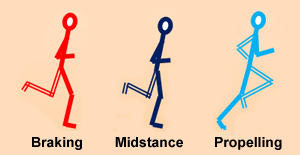
 About The Author
About The AuthorCanute, aka Peter Liddle has been running for over fifty years, and is currently training for what he describes as 'a reasonable marathon before the age of 70'. A PhD in physics, and a career in biomedical science have combined to produce his understanding of how the human body works.
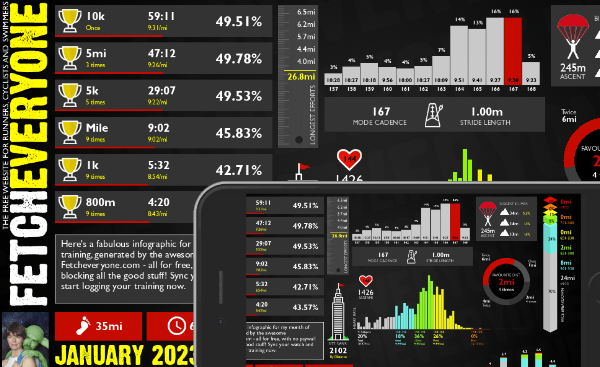
Monthly Summary
A brand new shareable infographic showing a colourful breakdown of your training month.
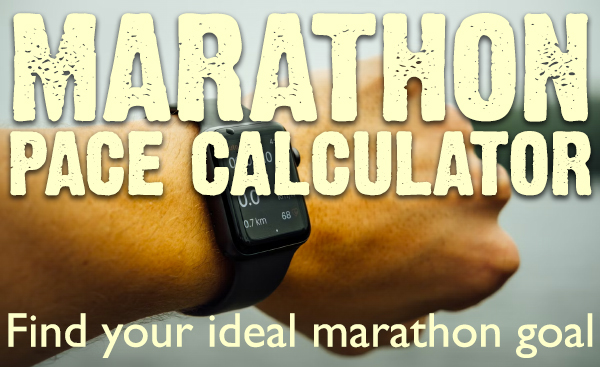
Marathon Prediction
We delve deeper to give you greater insights when working out your goal marathon time.
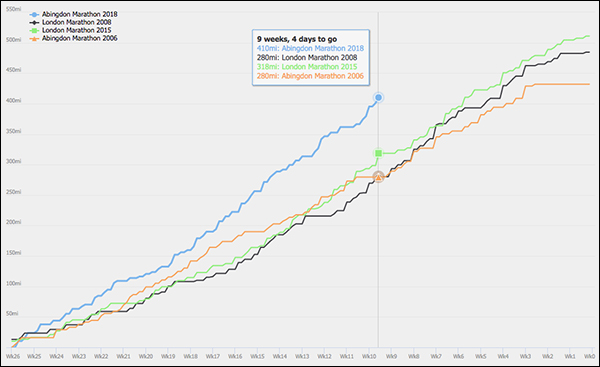
Pre-race Training Analysis
See your accumulated mileage in the weeks leading up to any event in your portfolio, and compare it to your other performances

Your 365 Day Totals
Peaks and troughs in training aren't easy to find. Unless you use this graph. Find out what your peak training volume really is
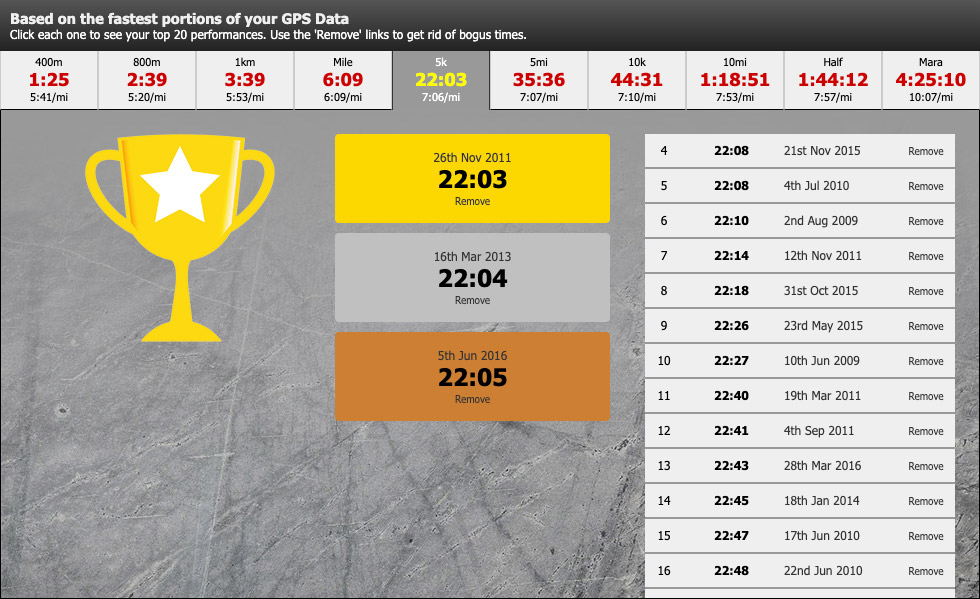
Benchmarks
See the fastest portions from all your training runs. Filter by time to give you recent bests to aim at. Every distance from 400m to marathon.
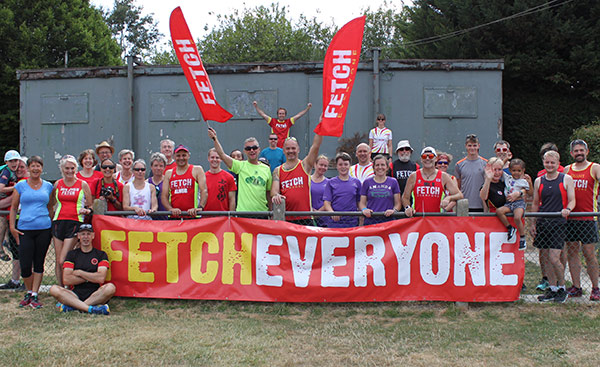
Fetch Everyone Running Club
Join our UKA-affiliated club for event discounts, London Marathon ballot places, the chance to get funded for coaching qualifications, and a warm feeling inside.

Leave a comment...
-
Great article thanks! I've done a Chi Running workshop and am running uninjured.....so far

Wendolene Wobbler
-
I thought this was a very clear and interesting article thank you very much.
KatieB
-
Pithy article that gets right to the essence of efficient running. Well written. I have already recommended it to my running friends.
Sweaty Frank
-
Oops! I meant to also mention that I have submitted this to reddit just to prevent multiple submissions.
Sweaty Frank
-
Nice article Canute

KOG
-
Clear and sensible as ever thanks. You haven't mentioned the prickly problem of learning a better way to run. I say this as someone who was curious about Pose in 2004 taking in all 3 workshops and several coaching sessions. The result was disastrous: pretty much injured throughout the decade. Silly of me not to have stopped but once I had encountered the alluring explanations and promises I couldn't leave it alone until I had mastered it.
olicav
-
Can we have more articles like this?
Chrisull
-
Olicav
Canute
-
A wee question - should you keep the same cadence on downhills - I always tend to take larger strides on downhill?
PentlandPounder
-
PP
Canute
-
The most clear thinking piece of writing on running style and efficiency that I've come across. No 'fashionable' theory no hocus pocus just good physics well explained. Well done

flyingfinn
-
great article and anything trhat helps us oldies keep moving for longer than others might expect of us has to be a good thing.
macca 53
-
Gosh some physics that I understood and which was relevant! Well done!
fleecy
-
LEDGE thank for your comment.
Canute
-
'Good' implies a degree of expertise in my view.
fetcheveryone
-
Only one Criticism - When did Gary leave Take That?
cabletow
-
I enjoyed this article. The way we run, I guess, has something to do with individual idiosyncracies and what we were born with and I agree with Canute (23rd May) we only need to check out style if we have persistent injury. When I was a member of a large running club we could identify individuals from a long way off by how they were moving--of course everyone was different and in the day (1980's) no-one really worried about style. I have altered some aspects of my running as a consequence of permanent neural damage and an inability to push off with my left foot as there is no reflex there now, but the only thing that really helps is variation in cadence. The article notes 180 a minute as producing around 7-9 minutes a mile...phew, if only! I might have done that in my thirties but now in my late sixties that would be going some! I tend to run best at 170 per minute and that gives me around 10 minute miles..but I have to remember my 'one legged' push off!
torey
-
oops...the above relates to ME not Torey who is my wife!! She's a lot faster then me and has had various injuries that have been corrected through good coaching and good physio input.
torey
To comment, you need to sign in or sign up!Some 9 years later I eventually gave up with too many injuries. The Pose guys were very nice but on the forum the response to my reports of injuries were treated as a great nuisance with me always being at fault. Not once did I get a sense that the whole teaching approach was in any way inappropriate.
With hindsight I would advocate Tweaking rather than wholesale change that is advocated.
I may well get some adverse responses by previous Pose friends from this seemingly disloyal account. And that I feel is the problem: the notion of loyalty to a set approach to running.
Thank you for your kind comments. I am sorry that you have had a frustrating time over the past decade. With regard to the practical question of how to learn to apply the principles of good running style I think that it is possible to learn to apply these principles largely by consciously attending to a few key issues when running. I have just posted a brief outline of what I believe are potentially useful strategies on the Efficient Running thread. However if things are not working out a good coach can be helpful especially a coach who can respond flexibly to the issues facing each individual rather than a dogmatic one size fits all approach.
Thanks all for your positive comments.
I'd also agree with Fenland Runner. Only serious injury I've had was when I tried to change my style too much to a more upright 'proper' style rather than my natural slouch. Had real hip and knee probs.Went back to normal style and been OK since. Guess I should have seen a trainer.
I think the most important thing about going downhill is maintaining soft knees (ie not too much tension in thigh muscles) to minimise jarring. I do usually increase both stride length and pace slightly because I enjoy the exhilaration of slightly greater speed without extra effort but I try to keep the footfall fairly light and avoid leaning forwards. Going uphill I shorten stride and increase cadence.
I agree that identifying a good coach is a tricky business. The theory of some of the popular styles is contrary to the laws of physics and indeed often contrary to what coaches in these styles actually do. For example my own observations indicate that Pose coaches like other runners elevate their body after mid-stance contrary to the Pose mantra of pose fall pull. Nonetheless when it come to practice I know of many recreational runners who have found that coaching by advocates of either Pose or Chi has enabled them to overcome persistent injury problems. I think that the explanation is that even though a mantra such as pose fall pull might be contra to reality it can produce a helpful mental image for a recreational runner who is inclined to push too hard and for too long after mid-stance. Drills such as Change of Stance can also promote good neuromuscular coordination. Unfortunately I also know runners for whom coaching has led to further injury problems.
So my own conclusion is that if you do not suffer from persistent injury there is no need to seek a style coach. If you do suffer persistent injury seek a coach who is not dogmatic and can offer a plausible explanation of what might be going wrong based on observation of your own style and weigh-up this advice against the general principles outlined above.